Our backyard water garden, filled from collected rainwater, is longer than the house–over sixty feet, comprised of pools of different shapes and sizes with narrow “chutes” of water between them. In this drought year, it’s the largest water source for wildlife for more than a mile in any direction: stock tanks are dry, the little water guzzlers on the 80 acres are much smaller, the nearest water in the creek is a mile downstream (and has dried up several times.)
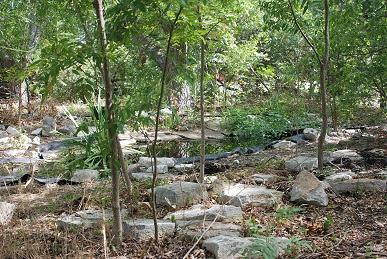
This upper end, narrow and partly shaded even in drought, attracts the shyer small birds and shade-preferring dragonflies.
Wildlife comes here to drink–with predictable effects on the different populations.
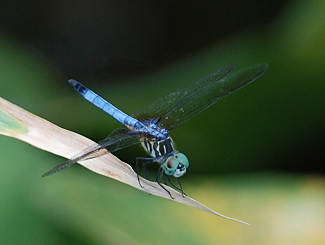
I spotted five or six male blue dashers, Pachydiplax longipennis, mostly at the lower, sunnier, lily pond end of the stream today. They were skirmishing with a larger, and very flashy, male widow skimmer, Libellula luctuosa:
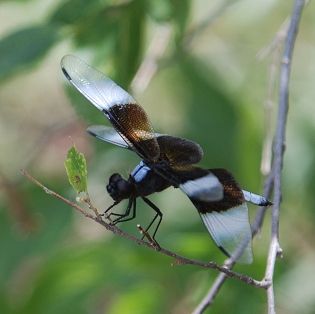
In addition to the year ’round birds, the fall migrants are moving through. I was able to photograph a yellow warbler coming to water just after noon, when it was already near 100 F.
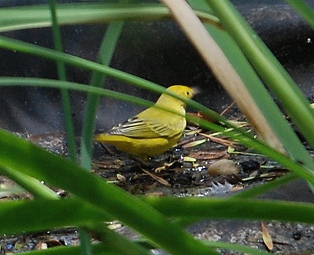
Other birds included cardinals, white-winged doves, Inca doves, Carolina wrens, house finch, black-chinned hummingbird, and a bird I couldn’t identify (barely seen)–by its size and song, another migrant warbler. A squirrel came to the first of the “stream channel” sections, both to drink and to pick up a green acorn off one of the red oaks. In the channel sections, the rubber liner is exposed.
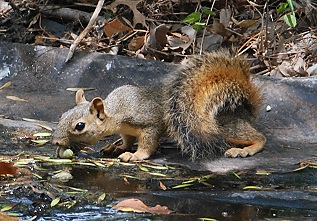
The wasp below may be a new species for the place–I’m not sure what it is. It’s got a long, thin pedicle between thorax and abdomen, but it’s big, like one of the larger Polistes paper wasps. It was very active, jerking around, lifting and landing, as it worked its way down the log to the pond to drink and back up. [Edit: Sceliphron caementarium]
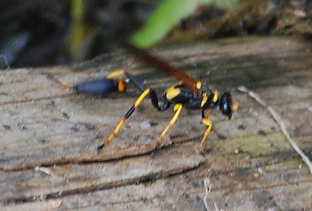
Today was another 0ver-100 day–we’ve had over 60 of them this summer.
Comment by Marjorie Procter-Smith — August 24, 2009 @ 6:53 pm
Wow, this is a timely post. I’ve been watching the roadrunners who come get a drink a couple of times a day at my small bird-bath, and pondered putting in a little ground-level pond near the house (much smaller scale than yours). You have a pump, I assume? What do you know about solar pumps? And you used a pond liner? I’m a little intimidated by putting one of those in. Advice?
Comment by elizabeth — August 24, 2009 @ 9:28 pm
If you have a small system, a solar-powered pump works pretty well. Both our remote wildlife waterers use solar-powered pumps. However, we’ve never had any luck with the battery-storage to make the pump run at night on stored energy…for whatever reason, we can’t get that to work right.
The last picture on this page http://www.elizabethmoon.com/land-views.htm is of the Fox Pavilion wildlife waterer when we first put it in…three purchased heavy plastic “fountain tubs” and a small solar-powered pump (you can see the solar panel in the background, on an overturned tub.) That system has maybe 40 gallons total in it, and a “lift” of maybe one foot.
The Owl Pavilion water is larger than that, but not as big as the house…it’s critical (esp. if you have quail) that there’s a very low-barrier entrance to the water, and the water is shallow but not stagnant. Quail had a problem with the Fox Pavilion water in the picture, so I added an “overflow” flat plastic “plate” thing…it’s actually one of those basins you put under large planter pots. I’ve seen armadillo and quail as well as other birds drinking from it.
Little birds–warblers and such–love a protected place to bathe that’s only about an inch, maybe inch and a half deep. A shelving “beach” works fine for them–they can go in to the depth they want. You can use a flat rock that slants into the water.
You’ll need some kind of liner–it can be hard plastic or a rubber membrane (the sheet plastic liners degrade quickly under Texas sun; the heavy-duty rubber ones don’t, but can be chewed–it’s happened to ours. Something decides to burrow under it, and then decides to enlarge the burrow…something with gnawing teeth, probably cotton rats or the like.)
For a simple small pond, consider a livestock water trough or feed tub (like the heavy-duty black feed tubs used for horses, or a Rubbermaid water trough. Or, if you go for bigger, one of the metal ones (but they will eventually rust out with this much contact with soil.) Dig a hole so that the lip of the container is at ground level. Put some gravel in the bottom. If you want the whole thing to be shallow, make a box/cage for your pump and put that in, then fill around and above it with coarse gravel so there’s easy water flow for the pump, and then fill the rest with medium gravel. Otherwise, create a “shelf” so there’s a very shallow area and a deeper area. (A lot depends on the exact size of your tub/pond.)
On the water return, you can keep it really simple (let water from the pump run out of a hose elevated a few inches above the water level in the pond) or create a rock cascade at the edge of the pond, or have water returned to another container sitting higher, but overflowing into the main one. Falling water oxygenates the pond; after awhile you get the right bacteria growing on your gravel, and that functions as a biological filter.
And that’s probably more than you wanted to know…at least, it’s getting late tonight and the farrier’s coming tomorrow to trim the horses, so I need to hit the sack and get up at a gallop.
Comment by Marjorie Procter-Smith — August 25, 2009 @ 9:10 am
Thanks! Perfect. NOT too much information at all; just enough to get me started. We even have an extra black rubber horse trough we can use. I have the farrier coming tomorrow morning, before (he hopes) it gets too hot. Good luck with that.
Comment by elizabeth — August 25, 2009 @ 10:04 am
I hope your farrier made it while it was still bearable…mine did. Shade was still on the barn lot, there was a breeze. Probably only 90 and maybe high 80s, but noticeably hotter by the time he left than when we started.
The hard thing is getting the horse trough level in the hole…and it’s worth having some sand in the bottom so you can work on that. One of our tubs is tipped over at Owl, and if they tip a little to start with, they tip more later. The runoff softens the ground under that side and the weight of the water shoves it in, every time it rains and runs over. We’ve used the deeper tubs to hold the pump and something else shallow for the birds, but I think it’d be easy enough to create a shallow end, maybe using concrete blocks or bricks to block off and fill with gravel. Oh–if you’re beset with raccoons, you need to buy or build a stout box for the pump–they mess with the plumbing, yanking on the hoses, the electric connection, etc.
For a 50 gallon system, you’ll need to refill a little every day in hot weather–otherwise in a day or two it’ll expose the pump. If that’s a 100 gallon horse trough, it may last longer. The Owl setup is over 250 gallon capacity (counting the tubs and the “stream”) and can go a day without a checkup if the raccoons haven’t pulled the pump up.
Here’s a picture of the two tubs in the ground at Owl, with a siphon between them.
I still think it should be possible to plumb a connector below-ground (the holes adjoined) so tadpoles, etc. could swim back and forth, but it would be harder to clean roots out of the siphon that way. Richard is convinced it would be nearly impossible to make the connection water-tight. (He could be right, but we do have connections from one rainwater storage tank to another.) The nearer tub is the un-level one. It tips to the left.
You should be warned that once you start building water features, even little ones…it’s addictive. And it’s hard to ‘finish’ them the way the pond-building books suggest, too. Ours are all rough around the edges. OTOH, if you use the “tub” method, they’re much less likely to leak than if you go elaborate (and have wildlife. I suspect there are professionally installed urban water features that don’t leak–but they don’t have deer dancing on the liner, cotton rats and pack rats trying to live underneath, raccoons hauling up the pump to see if it’s a crawdad, etc.
Good luck! Share pictures when you’re done.
Comment by Marjorie Procter-Smith — August 25, 2009 @ 11:07 am
You are very generous with your knowledge! Thanks for sharing. I expect the actual digging will wait until the weather cools a bit. My husband blanched visibly when I mentioned digging a hole in the ground for the horse trough. Plus, dry as it is, we would need to use a pick axe. Or dynamite. Meanwhile, though, I’ll research solar pumps and begin collecting rocks and the like. And we DO have raccoons who like to tip over my birdbath, so thanks for the tip on that. What kind of box would make the pump raccoon-proof–or at least raccoon-resistant?
Comment by elizabeth — August 25, 2009 @ 12:12 pm
My husband had the same look when I pointed out just now that if we just dug out a two-three foot hole eight feet in diameter, a 2500 gallon water storage tank would indeed fit under the edge of the hay-storage area off the carport…and two of them would give us 5000 gallons of storage, off the best roof collector area we’ve got near the house…gosh, I don’t know why they don’t want to dig holes in 100+ heat…
Ahem. Raccoon-proofing a pump…not entirely sure, since we haven’t yet figured that out completely, but we’re working on it. It just occurred to me, this minute, thinking about it, that if instead of the small hose and electrical cord, we ran those through a fat black hose, something too big and smooth for a ‘coon to grab and tug on easily, that might prevent the ‘coon pulling it up. We have one very determined family of them out in the woods that–once they get the pump up onto a little ledge thing built into that tub, will undo or chew through the fabric wrapping that’s supposed to keep stuff out of the pump inlet. (It will not keep *roots* out of the pump inlet…water lily roots, for instance. We lost a pump to water lily roots.) You can have a lily in your tub-pond but check the pump at least weekly to see if it’s been invaded…)
Anyway, my thought was that if you put the pump either under rocks (big and irregular enough to let water flow easily), or in a sturdy enclosure covered with rocks (like, um, a live-trap or any old container, non-toxic, with wire or slat sides water could get through, that you could weight down with rocks) the ‘coon wouldn’t be able to get in. But now I’m going to find Richard and see if he thinks the fat-hose idea would work for our problem at Owl. They almost never dislodge that siphon between the pools.
Comment by Marjorie Procter-Smith — August 25, 2009 @ 5:39 pm
Raccoons are incredibly resourceful. I could tell stories, like the one that stole baby bunnies out of nest boxes without opening the cages…well. So I do have an idea that it won’t be easy to discourage them. I was thinking a plastic milk crate might work? Weighted down with rocks? And I remember your problems with the water lilies and iris roots. Noted. The tubing idea is interesting. Like PVC pipe?
Comment by elizabeth — August 25, 2009 @ 8:02 pm
I was thinking of the more flexible black pipe (I don’t think it’s PVC but it could be a different PVC…) but PVC should work–it’s just so ugly. We did end up running the electrical line between the solar panel and the Fox Pavilion water through a length of PVC because some critter kept gnawing on it. Fox or raccoon, we thought. The problem at Owl was more that something kept snagging the line (we finally pegged it down with tent pegs) and yanking it loose from one end or the other. I suspect deer for that.
Comment by cdozo — January 6, 2012 @ 5:57 pm
I think the yellow bird is a female American Goldfinch. I built a model of one when I was a kid.
Comment by elizabeth — January 6, 2012 @ 7:17 pm
Carol, we never have American Goldfinches in August–they’re here only from November on–and this bird is a warbler. We do get migrating warblers starting in August, though most come through later. My guess on this bird is the Yellow Warbler, an adult female, because of the white edges on the feathers of the wings folded on the back. (It was also tiny–smaller and slimmer than an Am. goldfinch.)
I have other pictures of it somewhere in the files.